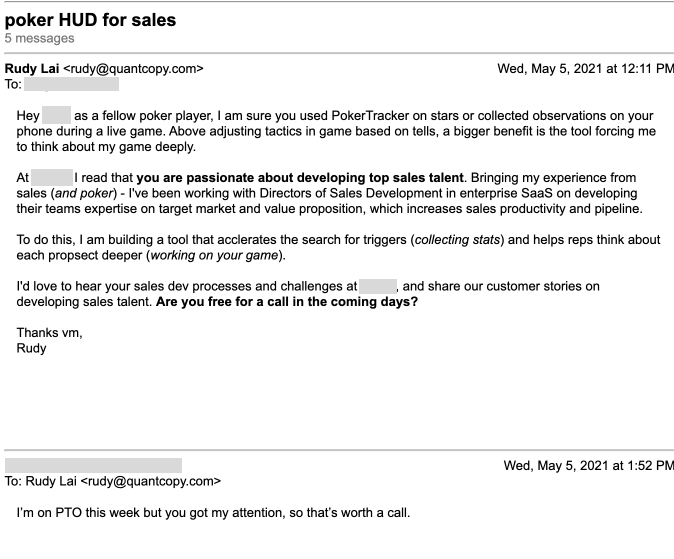Outbound personalisation at scale is a hot, evergreen topic. Every year, loads of startups attack this space, whether it is around automating video creation and email writing, coming up with new data points and triggers, or surfacing the right insight for sales teams. There is a lot of excitement around these tools, but we are finding that they don’t really stick. Why?
Turns out, personalisation is not the holy grail.
1. Personalisation requires stars to align.
I am sure we have all seen screenshots of an email like this:

While it does seem like everyday somebody else posts an amazing example of just the right, creative message to the right prospect, it’s really difficult to scale. That’s because you are relying on a long list of things to get to this level of personalisation:
there is insight available on the prospect
your team can find it
your team can spot the opportunity to personalise
your team has the skills to take that data point and relate it back to your message in a creative way
they can consistently do this and still hit activity targets
It’s like flipping a coin and praying that it lands on heads 5 times in a row.
2. You get a meeting. The wrong meeting.
There is nothing that beats the high of a positive reply. Everybody has their own stories of getting that quick reply with praise to your creative email/linkedin/present. (my current record: a reply in 12 minutes)
However, after doing this for a long time, I have noticed that optimising for getting the meeting really isn’t the goal. I frequently get onto the meeting, everybody is excited, we talk about the creative outreach, and then immediately afterwards we find out a key fact that means we have to disqualify the account.
This means that you have not only wasted time into research, copywriting, and booking the meeting, you have also wasted time for yourself and the prospect on a conversation that leads nowhere.
That’s really inefficient!
3. It increases the bar for hiring.
There are many frameworks on what makes a good prospector, but many sales teams have to consider additional factors: for example, if you have full cycle sales reps, prospecting skill may take a backseat to the ability to close big revenue.
Now, adding ‘creative copywriting’ as a skill on top, asking for reps to be able to take insights, synthesise it, and relate it in a creative way back to your messaging – that significantly narrows down your pool of candidates.
And hiring is hard enough!
4. It makes performance unpredictable.
Creative prospecting is an art – and that makes it unpredictable. The more creative you are, the more effort it takes (which lowers your efficiency), the harder it is to measure and optimise.
How would you scientifically, robustly measure the effectiveness of wording? Of a picture? Of a video? If you had the solution, it would be one of the most sought after pieces of martech in the world.
To be clear, I am not saying that we should all use generic, templated messaging in every channel. It’s about controlling as much of your GTM as possible, while using creative content as a bonus on top.
You don’t need personalisation, you need relevance: targeting, timing, messaging, and channel.
If personalisation is not the answer, then what is? One day, in a user interview, we learned of a new way. We were speaking to a rep in a public SaaS company renowned for its sales productivity. He says,
“Our account lists are amazing. There are 80 accounts on there. You just need to pick up the phone, pitch your value prop, and magically they would have that need. It’s crazy!”
To us, that’s the holy grail. Find the 80 accounts with so much product market fit that you can just pitch. No need to find the prospect who likes the same sports team. No need for alumni networks.
Then it hit us: personalising the message needs to be just the last mile. People often say “personalisation” to mean a mix of targeting, timing, and messaging. Scaling personalisation is not about enabling a rep to be very productive, but automating that away from them entirely, so they can focus on what they do best.
And this is why point solutions rarely stick: outbound personalisation is the symptom, not the root cause. To properly increase outbound (and GTM in general) efficiency, we can break it down into four steps.
Targeting. Make sure your target account lists has a high fit to your ideal customer profile(s). Doing this in a data driven way makes the process more predictable.
Timing. Crowdsource great triggers across the buyer journey, and make sure you surface those consistently across your teams. Buying triggers, upsell triggers, churn triggers.
Messaging. Build a messaging system that maps every persona and every trigger to the right message.
Channel. Find the right channel for different personas, whether it is video, calls, email, or social.
Tactic helps you do this in a data driven way.
We’ve learned all of this through 500+ interviews with high growth, B2B businesses. If you would like to talk about putting structure and automation around targeting, timing, and messaging, let’s have a chat!

